Chickens
The Most Popular Chicken Breeds
There are various types of chicken breeds that you can raise for home, educational, or business purposes.
This list of pure breeds will serve as your ultimate guide and after you have found the best breed for you, feel free to browse our large selection of chicken coops.
Ancona
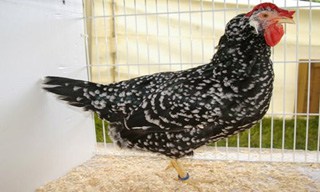 Common Breed Names: Ancona
Common Breed Names: Ancona
Alternative Breed Names: N/A
Description:
Ancona originated in Marche, Italy, although their current type was developed in the UK. They can produce as much as 220 eggs annually with slight tendencies to be broody. They are hardy, lively, and rustic. This breed is active and may come in single or rose combed variety. They are free ranging and are great foragers.
Andalusian
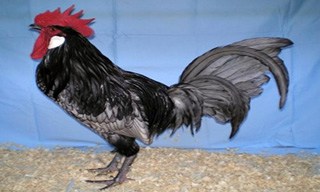
Alternative Breed Names: N/A
Description:
Andalusians originated in Andalusia, Spain. They have dark and light blue plumage, dark blue hackle and saddle feathers, light blue breast. Their feathers are laced while the sickle feathers and tail are almost black. They have white earlobes, but red wattles and face. They also have slate blue toes and legs. Andalusians are active, small, noisy, and hardy. They are free ranging and make good backyard chickens.
Araucana
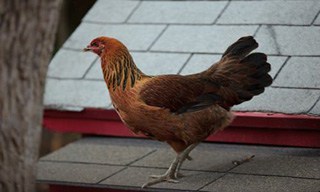
Alternative Breed Names: N/A
Description:
Araucanas originated in Chile. They lay blue eggs, have green legs and feet with yellow undersides. All of them have dark orange eyes and a red pea comb. Tailed Araucanas have a beard, crest, and muffling, but no ear tufts, while rumples Araucanas have ear tufts with the same size, thick beard and muffling, but no crest and tailbone. They are great foragers, hardy, and friendly.
Australorp
Common Breed Names: Black Australorp, Australian Orpington,
Alternative Breed Names: Australs
Description:
Australorps have large, soft feathers, black leaks and beak, white toenails, upright single comb of average size and five distinguishable points. They are tame, docile, and can take being handled. They are good hen mothers, good egg-layers and broody too. It is of Australian origin.
Appenzeller
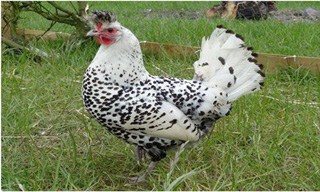
Alternative Breed Names: N/A
Description:
Appenzeller originated in Appenzell, Switzerland. There are two kinds – the Spitzhauben, which has a V-comb and feather crests and the Barthuhner, which has no crest, only a rose comb. They are mostly raised as show birds. They are not broody and are excellent foragers. They are also friendly.
Barnevelder
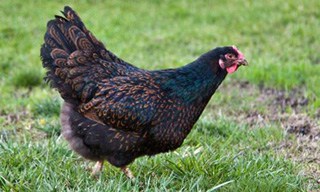
Alternative Breed Names:N/A
Description:
Barnevelders originated in Barneveld in The Netherlands. They are raised mainly as show birds and utility chickens. They are very hardy, polished, calm, and friendly. They also have glossy green feathers and produce around 170 dark brown eggs per season. They have a red comb, yellow feet and beak, and orange eyes.
Brahma
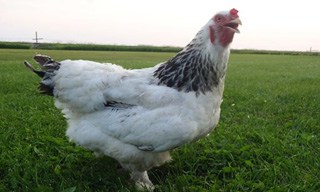
Alternative Breed Names: N/A
Description:
Brahma originated in the US, although they were developed from large birds imported from Shanghai. They are large birds with a large head, an upright carriage, and fluffy feathers. They are cuddly and friendly, although they seem childish in nature and eat a lot. They are good pets for young children who want a huggable friend.
Campine
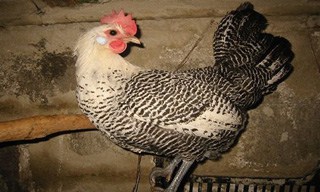
Alternative Breed Names: N/A
Description:
Campines originated in the Campine region of Belgium. They are found in gold and silver varieties and are quite small in stature. They are mostly raised as show birds. They are lively and free ranging. They are also inquisitive and alert. Some of them are friendly, while others are a bit wild. They are average egg layers, less cold hardy, and their combs often get frostbite.
Catalana
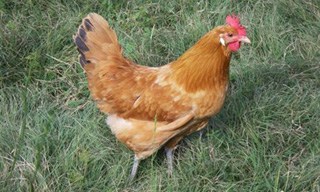
Alternative Breed Names: Catalana del Prat Lleonada
Description:
Catalanas originated in Catalonia. They have a golden plumage that earned them the name ‘Buff Catalana.’ They are kept for their meat and eggs. They are popular in the South and Central America, but are rarely grown in North America. They have a single comb and four toes. Catalanas don’t have feathered legs and have no crest. They are not hardy in winter, resent confinement, rarely broody, but are good foragers and active breeds.
Cochin
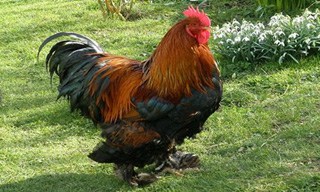
Alternative Breed Names: N/A
Description:
Cochins originated in China. They stand out because of their excessive plumage that almost hides their foot and leg. They have yellow skin and are found in colours including black, cluff, patridge, splash, silver laced, golden laced, blue, and white, Cochins are great mothers and good foster mothers. They are good egg layers in the first few years. They are among the friendliest breeds.
Cream Legbar
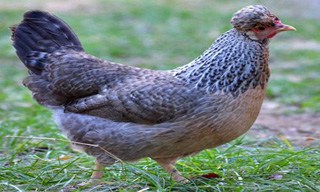
Alternative Breed Names: N/A
Description:
Cream Legbar is an old pure breed that can lay blue, olive or green eggs. They are muscular birds with large wings, long and flat back, and a tail that is at a 45 degree angle to the back. They have a single comb with five to seven spikes and have a strong beak. Cream Legbars are autosexing breeds that can lay around 240 eggs for their first year.
Croad Langhsan
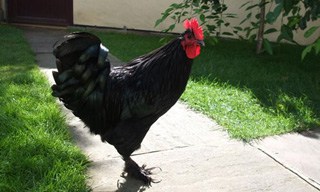
Alternative Breed Names: N/A
Description:
Croad Langshans originated in China. They are heavy but graceful with soft feathers. They also have a U-shaped appearance because both head and tail are at the same level. They have brown eyes with a beak that are go light at the tip. Croad Langshans have bright red wattles, comb and earlobes, but have feathered, grey legs. They are active, intelligent, and strong. The hens are good mothers. They have to be sheltered in a dry place.
Dominique
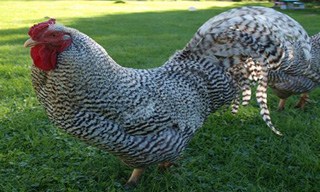
Alternative Breed Names: Dominickers, Pilgrim Fowls
Description:
Dominiques are the oldest pure breed in America. They have a rose comb, a mottled appearance due to their plumage, and have a colour that is not really black but not quite white either. They are nurturing and caring mothers that can produce 160 to 200 large brown eggs per year. Dominiques can bear confinement and are broody. They are docile and hardy too.
Dorking
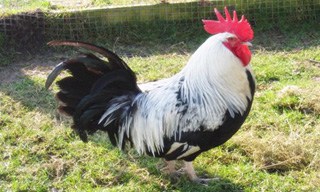
Alternative Breed Names: Silver Grey Dorking
Description:
Dorkings are among the ancient English breeds in the UK, though they were thought to have originated in Italy. They are best characterised by their extra hind toe. They are also the only red-earlobed breed to produce white eggs. Dorkings have relatively short legs compared to other breeds. They are sweet but hardy. They are docile, gentle, shy, and bear confinement well.
Dutch Bantam
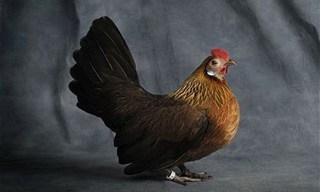
Alternative Breed Names: Hollandse Krielsen
Description:
Dutch Bantams originated in The Netherlands. They are among the true bantam breeds that don’t have a large fowl counterpart. They are mostly kept as exhibition poultry. Dutch Bantams can fly well because of their small size and large wings. They are flighty but friendly. They are cold hardy, good mother hens, and broody. Although they are show birds, they are good layers laying 160 eggs per year.
Faverolles
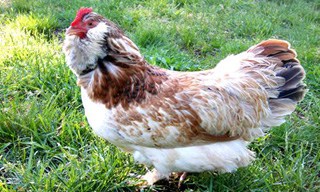
Alternative Breed Names: N/A
Description:
Faverolles was developed in France. They are kept for eggs, utility, and exhibition. They are heavy with muffs, a beard, five toes, and feathered feet. They can be confined or free ranging. Faverolles are extremely docile and are great winter layers, making them good pets. They are especially popular among children because of their gentleness.
Fayoumi
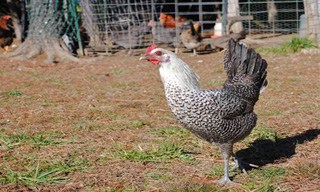
Alternative Breed Names: Egyptian Fayoumi, Bigawe
Description:
Fayoumis originated in Egypt. They are often compared to roadrunners because of their forward jutting neck and breast and upright tails. They are lightweight, have red wattles and earlobes with a white spot, a single comb. They also have slate blue skin and dark beaks. Fayoumis are quite vocal and cannot be fully tamed. Since they are flighty, fencing has to be installed. They are great foragers and prefer free ranging.
Friesian
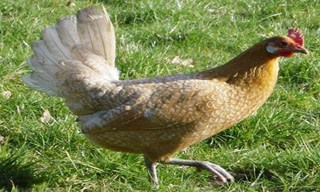
Alternative Breed Names: N/A
Description:
Friesians were developed in Friesland in The Netherlands. They are average in size and quite flighty. They are good layers of around 230 small eggs per year. However, they are not broody. Friesians are found in silver pencilled, gold pencilled, and chamois pencilled colours. The chamois type is the most attractive.
Frizzle
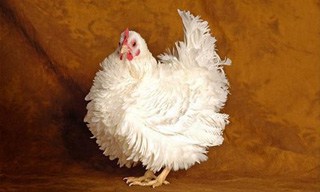
Alternative Breed Names: N/A
Description:
Frizzles are believed to have originated in Asia. They are mainly kept as show birds. Each feather curls towards their head and are quite long. Their neck is full of frizzled feathers and each one has a ragged appearance. Since they don’t have waterproofed feathers, housing is important for them. They are hardy and mature quickly. They can be free ranging or sheltered in outdoor pens.
German Langshan
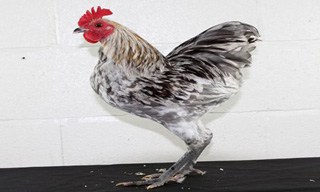
Alternative Breed Names: N/A
Description:
German Langshans were developed in Germany off Croad Langshans. They are tall, large, and robust. They are kept for their meat and for entertainment. This breed has a long tail with a contoured back. They also have an upright posture, long, bare legs, and a single comb. They are mainly found in black, blue, and white. They can be tamed easily.
Hamburg
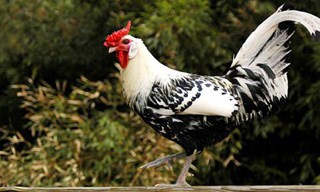
Alternative Breed Names: Dutch Everyday Layers, Everlayers
Description:
Hamburgs were developed in Holland and Germany before the 1700’s. They are small, around 5 pounds for cocks and 4 pounds for hens. They have a rose comb and slender legs. They are hardy, active, alert, and flighty so fencing is necessary. However, they love being free ranging so they might not respond well to confinement. They are not broody and not docile either.
Houdan
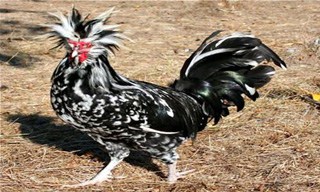
Alternative Breed Names: N/A
Description:
Houdans originated in Houdan, France. They were originally kept for meat and eggs, but are now more commonly used for exhibition. They are good layers, have five toes, and a V-shaped comb. Houdans have feather bearing, a crest that hides their wattles, and small earlobes. They are found in white and mottled varieties. They are friendly, funny, but flighty.
Ixworth
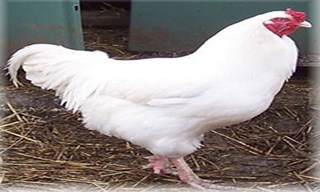
Alternative Breed Names: N/A
Description:
Ixworths were developed in the Ixworth, a village in Suffolk, England. They are kept for their eggs and meat. They have a pea comb, white plumage, pinky-white legs and beak, and orange to red eyes. They are active, alert, and free ranging. Their hens do tend to go broody.
Japanese Bantam
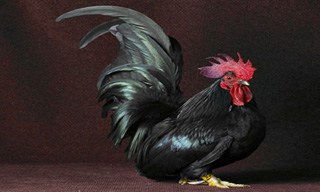
Alternative Breed Names: Jap Bantam
Description:
Japanese Bantams originated in Japan. Like any other bantam breed, they have large upright tails that are higher than their head. They have a single comb, red ear lobes, orange, red, or dark eyes, feather-free and short legs, and yellow legs. They are calm and make good pets. However, they have to be sheltered to avoid matted feathers. They are great foragers and good mothers.
Kraienkoppe
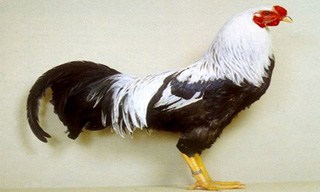
Alternative Breed Names: Twentse
Description:
Kraeinkoppes were developed in the region right in the middle of Germany and The Netherlands. They are small, upright, and thick-feathered. They have red ear lobes, yellow shanks and feet, muscled thighs, overhanging brows, a walnut comb, and tight feathering. They are found in Black-breasted Red and Silver varieties. They can produce around 180 to 200 eggs during the first year. They are active, lively, and good foragers.
La Fleche
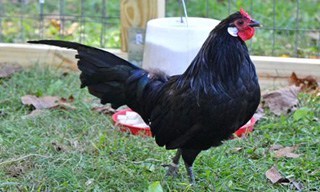
Alternative Breed Names: Devil Bird
Description:
La Fleches first rose to popularity in the UK. They are nicknamed the Devil Bird because of their V combs. They also have large white earlobes, normal four toes, no feathered legs, and no rest. They are great foragers but do avoid human contact. They are good flyers so they usually stay in trees. They don’t bear confinement as well and often remain untamed.
Leghorn
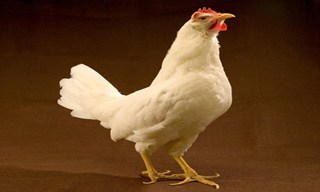
Alternative Breed Names: Italians
Description:
Leghorns appear to have originated in rural Tuscany. They are found in a variety of colours, depending on the poultry association in the country although they started out being black, brown, white and expanded to red, light brown, dark brown, black-tailed red, silver, buff, blue, lavender, and more. They have white earlobes, bright yellow legs, and usually have single combs.
Lakenvelder
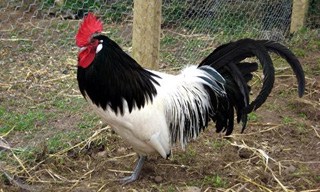
Alternative Breed Names: Lakenfelders
Description:
Lakenvelders originated in Germany. They have a black collar, head, and tail, but a white skin, white body, and slate coloured legs. They are flighty, free ranging, and good foragers. However, they can still be confined. Although they are good layers, they are not broody. Lakenvelders are also very hardy, self-sufficient, and effective bug catchers.
Marans
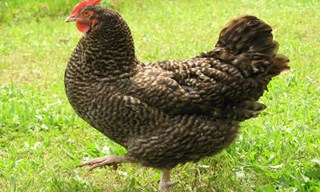
Alternative Breed Names: Poule de Marans, Country Hen
Description:
Marans originated in France. They are raised for their fine meat and extremely dark eggs. They are well built of medium size with their plumage close to the body. They look strong with one red comb. They also have grey or white legs with sparsely feathered toe and limb. They are active free rangers, independent, and very hardy. However, they can be tamed easily.
Marsh Daisy
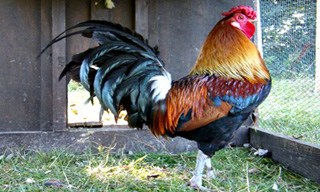
Alternative Breed Names: N/A
Description:
Marsh Daisy originated in Lancashire, England. They were named as such possibly due to their rose comb that looks like a Marsh Daisy flower. They also have white earlobes, willow green legs, striking colours, and an upright stance. They are gentle, free ranging, and good at flying. The Marsh Daisy breed does not mind getting wet too.
Orpington
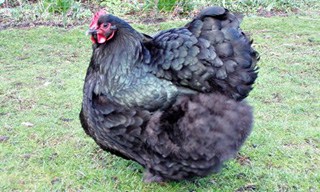
Alternative Breed Names: N/A
Description:
Orpingtons are large birds with profuse feathering. They have a single comb, gentle colours, and rich colours that make them excellent show birds. They frequently go broody and are good mothers. Since they can rarely fly, they make good backyard birds. Because of their large build, they can live in very cold climates. They originated in Orpington, England.
Pekin
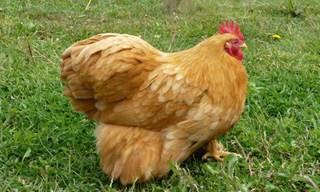
Alternative Breed Names: Pekin Bantam, Cochin Bantam
Description:
Pekins are of Chinese origin. They are about 20-30 centimetres tall and have thick feathers in their legs and feet. They are only found in bantam size. Their outstanding characteristic is the way their head tilts closer to the ground. They have a well rounded and thick-feathered tail. Pekins are found in a multitude of colours. They are calm, good pets, broody, and good mothers, although not very good egg layers.
Plymouth Rock
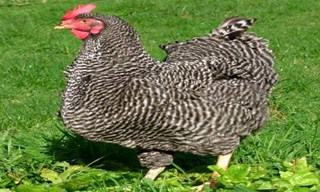
Alternative Breed Names: Rocks, Barred Rocks
Description:
Plymouth Rocks were developed in the US. There are large fowls and bantam varieties available. They are mainly raised for dual purpose. They have yellow legs and skin, a long, broad back, and a moderately deep but full breast. Plymouth Rocks also have bay-coloured eyes, red earlobes, a single comb, and a bright yellow beak. They make good pets because of their calm nature. They are good layers and good mothers.
Rhode Island Red
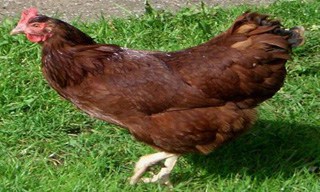
Alternative Breed Names: RIR
Description:
Rhode Island Red originated in the USA. They are raised for eggs, meat or entertainment. They have rust-coloured feathers that tend to go dark. They have yellow feet, red-orange eyes, and reddish-brown beaks. They lay an average of 200 eggs per year. They are easy to keep, hardy, and adaptable. They are calm.
Sebright Bantam
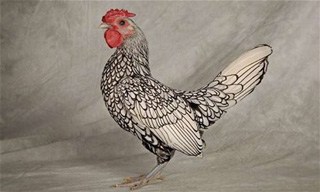
Alternative Breed Names: Sebright
Description:
Sebrights are among the oldest British true bantam breeds that were developed in the 19th century. They are mostly kept as ornamental birds. They are very small with proportionally large breasts, short backs, and downward-pointing wings. Sebrights are among a few breeds wherein roosters have hen feathers since they don’t have the typical long, sickle feathers found in most roosters.
Serama
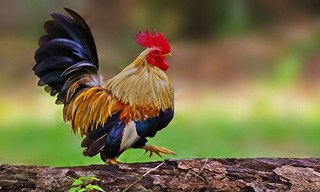
Alternative Breed Names: Malaysian Serama
Description:
Seramas are of Malay origin. They have a full breast, upright posture, wings almost touching the ground, and a neat comb. Their tail is at a perfect 90 degree and almost touching the back of their head. They are basically little birds with the smallest of their kind weighing just 350g. Since they are friendly, confident, and love people, they make good pets.
Silkie
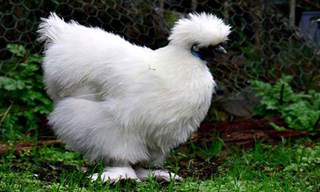
Alternative Breed Names: Silky
Description:
Silkie are said to have originated in Asia. They have black eyes, black skin, an almost circular comb, concave wattles, smooth face, oval-like blue earlobes, and large, flowing hackle. They also have short legs and thighs set wide apart. This breed is known for their fluffy plumage. They have five toes instead of the usual four. They make good pets, good mothers, and layers.
Sultan
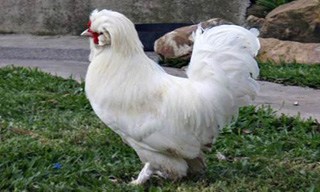
Alternative Breed Names: Serai-Tavuk, Serai Taook
Description:
Sultans were developed in Turkey. Serai Tavuk means “fowls of the Sultan.” They are mainly kept as show birds. Sultans are characterised by their large, puffy chests, long tails, beards, and excessive foot feathering. They also have small, V-shaped combs that are almost concealed by their feathering. They have one extra toe. They are not broody and are slow egg layers but they are friendly, docile, and bear confinement well.
Sussex
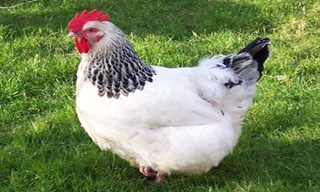
Alternative Breed Names: Sussex
Description:
Sussex chickens are of Sussex, England origin in AD 43. They are found in colours brown, light, buff, red, silver, speckled, coronation, and white. They are docile, adaptable, and alert. They can be confined or allowed to roam freely around humans. This breed is a good forager and sometimes broody. They have black wing tips, a black tail, and black and white stripes on the neck.
Thuringian
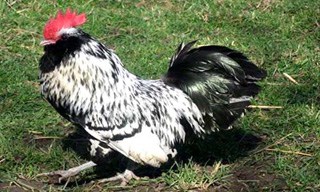
Alternative Breed Names: Chubby Cheeks
Description:
Thuringians are of German origin. They are medium-sized, active, and mature fast. This means they start laying eggs early. They have tiny wattles and large fluffy beards. Thuringians are also good foragers and hardy ones. They are good mothers but rarely go broody. All of them have a dark beak and brown eyes.
Tolbunt Poland
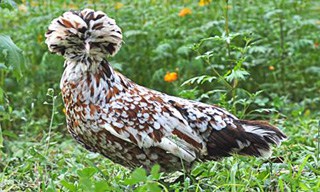
Alternative Breed Names: Poland
Description:
Tolbunt Poland originated in The Netherlands. They are famous for their crest of feathers. They also have large nostrils and a V-shaped comb. This breed makes excellent show birds and great white egg layers. They are active but can be tamed. Due to their limited vision from their large crest, they are easily startled and require extra care.
Welsummer
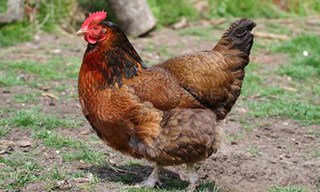
Alternative Breed Names: N/A
Description:
Welsummer are best known for being the Kelloggs Cornflakes rooster. They were developed in Welsum, Netherlands. They have a red face, a single comb, and bright yellow and red eyes. They are easy to deal with and quite calm. They are good foragers, lay dark brown eggs, and are hardy.
Wyandotte
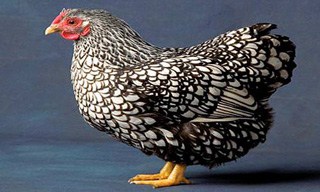
Alternative Breed Names: N/A
Description:
Wyandotte originated in the US in the 1870’s. They are of medium build, have clean legs and a rose comb. They have yellow legs, loosely fitting and broad feathers, and fluffy vent area. The most popular types are the silver laced and gold laced chickens. They are friendly, docile, and quite good pets. They can produce 200 eggs annually.
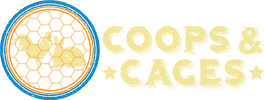


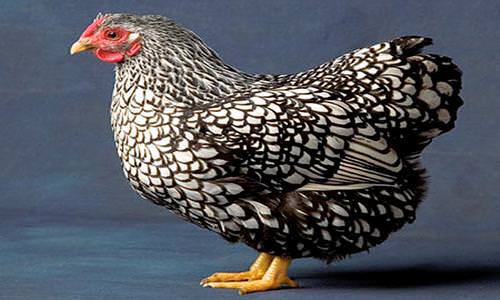
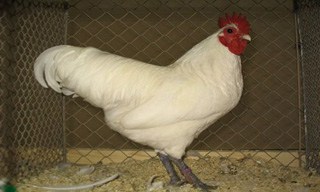
hello,
can you please advise me if different breed chicken can stay in the same pens. or do they have a problem?
im looking at getting a combination of
Silkie, Pekin and hy-line brown at the moment just one of each.
happy to take your suggestion on board.
thanks
rav
Hi, Rav. Most breeds do well together. And they can also be tamed. 🙂
What breed crossed with rhode island red produces a black sex link
Why didn’t you list the brown and yellow rooster? I have a rooster, and his legs are golden. He’s aggressive pretty much only to me, and I really want to know what breed it is. Please mention that?
Hi, Peachy! Okay, will think about that. What specific breed is that? 😀
we was given a white to light brown hen and we notice that she has no toes on either feet we was wondering if this is because of the type of hen she maybe or could be something else?she seems perfectly healthy other wise
Oh my!! Sounds like she may have suffered frostbite. Poor baby!!
why didn’t you list the ‘Isa Brown’ being the most common kept chicken breed for egg laying in my area.
Hello, Kez. Sorry that I forgot to list the Isa Brown on that. However, I made sure she’s included here: https://www.coopsandcages.com.au/blog/popular-egg-laying-breeds-australia/ 😀
I have 2 birds I got at easter. They were dyed orange and green. Now they are all white one with orange legs and beak. 2 with white legs and beak. Any ideas as what they might be??
Hello, Donna. Maybe you can share photos of your birds? 🙂
Probably White Leghorn cockerels. These are often dyed different colors for Easter. When they shed off the colored down, they are white.
I have this awesome looking roo and cant figure out his breed..got him right from a hatchery..he is 1 year old..he is all white. with brown tips on his wings and some of the brown goes across his back..it wont let me post a pick
Hi, Theresa. Can you show me a photo? 🙂
I was actually looking to buy some Dominique breed trio
Actually you have 44 breeds, out of the 50 registered in Australia, which is closer than I thought. But I noticed right away that Dorking and Naked Neck were missing.
I want hens: common Breed Names: Fayoumi
Alternative Breed Names: Egyptian Fayoumi, Bigawe
Description:
Fayoumis originated in Egypt. They are often compared to roadrunners because of their forward jutting neck and breast and upright tails. They are lightweight, have red wattles and earlobes with a white spot, a single large heave red thick comb.
Hi. we rescued a chicken and it turned into a rooster. We are trying to find out what breed it is. At first we thought it was a turkey because the legs were so big. Not a turkey. It stands upright with a bold chest. It is only a teenager so I guess it’s colours are still settling (?) it is black with red on the neck and lower back with a black tail. the tail generally sits down. (most pictures I see are with the tail up). It looks a little like this:
/Users/brookealder/Desktop/Screen Shot 2017-06-07 at 12.33.42 PM.png
or this…
/Users/brookealder/Desktop/Screen Shot 2017-06-07 at 12.27.35 PM.png
I cannot find my Chicken in this list and I do not know what kind of Chicken she is.
Hey I have this one bird and I can’t figure out what breed she is. She looks a lot like the Australorp that you have listed, eccept she has lavender splashes all over her. Do you mabe know what breed she is?
My favourite is the barnevelder. had them for nearly 20 years now and they can’t be beaten
I am Dana from NC, also a poultry lover I need a list of black chicken breeds but not found. Please help me.
The red sex link is my favorite all around. She is funny, friendly, and lays large eggs often. We love her.
Good afternoon. Thank you…Useful article!.
What about wyandottes? (Sorry I know this is an old post but wyandottes are kinda popular)